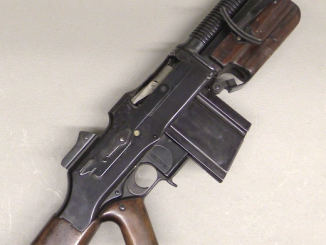After World War Two, Luxembourg was one of the nations which opted to purchase new FN-49 rifles. It bought a total of 6,203 of them for the military – an initial purchase of 4,000 semiauto SAFN rifles and a followup purchase of 2,000 AFN select-fire rifles and 203 semiauto rifles fitted with Belgian OIP telescopic sights. The scope mounts were commercial Echo mounts, designed and manufactured by an American engineer named Herkner, in Boise Idaho.
When Luxembourg replaced its FN49 rifles with the newer FN FAL type, the snipers were either scrapped or sold as surplus, but the scopes were kept and reused on FALs. However, the Luxembourg rifles used the same pattern OIP scopes as the Belgian military, and these are often found mounted to surviving Luxembourg rifles.



It’s freezing cold where I am right now, so I do have to mention that the FN-49 had a great reputation for functionality in winters that would freeze the M1 Garand shut. I wonder how many communists got beheaded by Belgian bullets in Korea… Did I mess up?
“winters that would freeze the M1 Garand shut”
I didn’t heard about this. M1 Garand was also used during Korean War and according to http://www.pattonhq.com/garand.html
S.L.A. Marshall(…)noted the phenomenal love of the American infantryman for the weapon, who, without reservation, candidly stated to him on over a hundred occasions that he could not think of replacing it with anything else.
In fact it was replaced by M14 – did they introduced improvements over M1 supposed to increase reliability in cold environment? If not that is hint that M1 Garand worked reasonably well even in cold temperature.
As I gather, the most serious problem with M1 rifle was preponderance to snap on shooter’s thumb when loading magazine. Perhaps the most successful upgrade of it was in form of BM59.
Agreed, Beretta did a great job…
The Garand reportedly had issues during the Battle of the Bulge and during the Korean War. If the receiver got wet during a winter fight, the bolt eventually got frozen stuck after the shooting was done if the user didn’t immediately strip the rifle and clean it.
I read that when the bolts froze during the Bluge the GIs found that urinating on the bolt would unfreeze it. Frozen bolts are usually a result of bringing a cold rifle into a warm shelter and condensation forming on the metal and then taking the rifle back out into the cold where the condensation freezes. Leaving the rifle outside the shelter in the cold solves this problem.
The acronym ABL is found on everithing issued by the Belgian military up to and including underwear and is bilingual ” Armée Belge / Belgische Leger “
the part on the scope that you thought was german, is actually belgian-dutch.. it’s short for “Scherpschutter” which means Sharpshooter.
Well preserved samples and excellent explanation, as we are used to. I like the SAFN rifle a lot. Interestingly, it still carried on with non detachable magazine, a legacy of old school thinking.
I am bit surprised Luxembourg had its own military; after all Germany was/is occupied by foreign powers and there is practically no threat to their sovereignty.
https://en.wikipedia.org/wiki/Luxembourg
With cca 570k population and 2.5k kmsq. area Luxembourg is perhaps the richest (and also most expensive) country in EU.
I think the Luxembourgeoise don’t like the idea of being occupied, hence the army.
As historical tidbit: Liechtenstein (no standing army in 20th century) was invaded by… Switzerland… more than once, but in all cases unwittingly
https://www.warhistoryonline.com/history/witzerland-invaded-liechtenstein-by-mistake-x.html
I have no doubt they had traditionally passion for independence, much like Czechs did during middle ages. Actually, Czechs have direct connection to Duchy of Luxembourg. Duke Jean of Luxembourg became in 1310 Czech king
https://en.wikipedia.org/wiki/John_of_Bohemia
He was killed at battle of Crecy in 1346 after, while his sight was disabled, refused to leave the battle. His son Charles IV became famous Czech king and Holy Roman Emperor.
“still carried on with non detachable magazine, a legacy of old school thinking.”
49 suggest 1949, while this might be true in terms of availability first prototypes were crafted yet in 1930s, see 1st photo from: https://modernfirearms.net/en/military-rifles/self-loading-rifles/belgium-self-loading-rifles/fn-safn-49-eng/
Have the 7mm version of this and the gas port at the front can catch you offguard. If it is not set to semi-auto, the rifle will fire one round and not cycle. Caught me the first time I tried it after plenty of time with a Garand. “WTF?”
Nothing a Youtube video couldn’t sort out.
BTW- They are very sweet shooting rifles. 7mm has a very reasonable recoil.
Bought a 7MM FN-49 from Century Arms in 1971 for $79.50. Shot very well. A sweet firearm. Wish I still had it.
The FN1949’s magazine housing copies the shape of the French MAS-1949